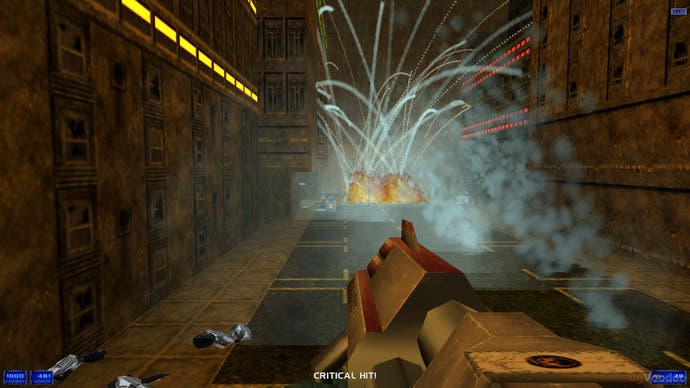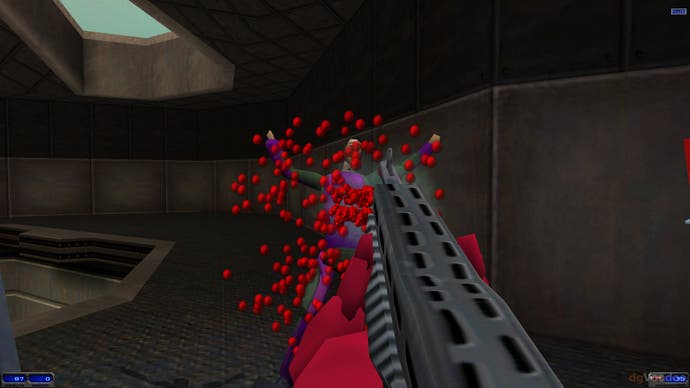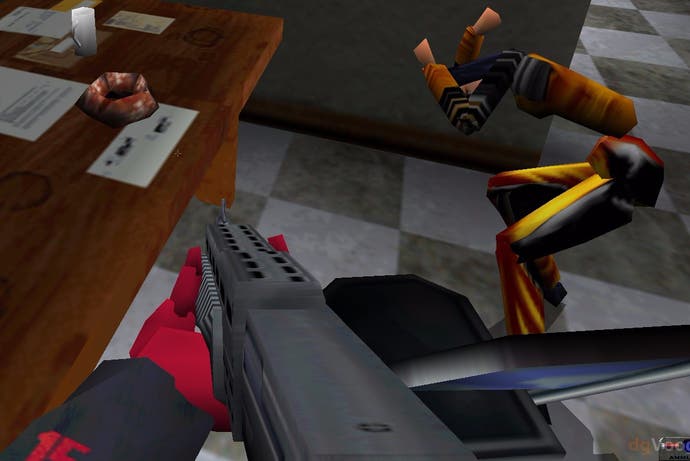SHOGO: Mobile Armor Division - Monolith's forgotten mech shooter
Studio gibly.
SHOGO is Monolith's forgotten shooter, and nothing demonstrates this more aptly than the fact I have discovered it twice. The first time was a few years after it released in 1998, when I found the CD case in my game collection and decided to give it a shot. Weirdly, I have no recollection of buying it or borrowing it. It just appeared in my house, like a MacGuffin that unleashes an evil spirit in a horror movie.
Anyway, after being initially put off by the anime stylings of the cover, because I didn't know what anime was back then and thought it was a cartoon for babies, I played it and enjoyed it far more than I thought I was going to. I then promptly forgot about it for ten years, until news circled around that it had been re-released on GOG.
At this point a small and dust-covered trapdoor was unlocked in my mind. All the memories came flooding back, and I resolved to play it again. It took a few years before I got around to doing this, but now I have I can't believe that I forgot about this game. Not because it's a fantastic shooter, but because it's such a fantastically odd shooter that's as broken as it is brilliant.

SHOGO makes a ridiculous number of mistakes in its execution. It's janky, it's thematically confused, and its ambitions stretch way beyond its capability. Yet somehow it still ends up fun to play.
SHOGO is a strange game from the concept up. Influence in game-making between Japan and the West has crisscrossed over the Pacific since the days of Donkey Kong, but SHOGO is a specific and unusual variant of that, namely, an American developer making a game directly inspired by anime. SHOGO rides a wave of Western interest in anime that arose in the mid-90s, commencing with the release of Ghost in the Shell in 1995, and culminating in the release of the Matrix in 1999. SHOGO itself takes inspiration from mech-tastic Manga series such as Appleseed.
In and of itself there's nothing wrong with this. The problem is that SHOGO is also the debut game for Monolith's LithTech engine, which would go on to power visually groundbreaking games such as F.E.A.R, and is still used today in Shadow of Mordor. Back in 1998 however, Lithtech was basic even compared to contemporaries like Unreal and Thief, with blocky environments and character models that are straight out of a Lynchian nightmare-scape.
When you've got a Western developer with an early and experimental 3D engine aping a highly stylised Japanese artform, the results are predictably catastrophic. SHOGO looks nothing whatsoever like anime. In fact, it looks like every other FPS released in the mid-to-late 90s. Worse, the bits which do resemble anime really stick out, from the skimpily dressed anime girls adorning the game world on posters and vending machines, to the exclamation marks that appear above character heads when they spot you. Perhaps the worst thing is that, when a character speaks, their portrait appears in the top left corner, which shows you what they should look like.
The LithTech engine causes other issues too. Characters seems to skate around the environments when they walk. Enemies react strangely when they see you, shifting instantaneously from inaction to bloodthirsty rage. Weirdest of all are the gibs. Enemies don't break apart when they're hit by a rocket or a shotgun blast, instead, their corpse seems to suffer from abrupt rigormortis, then bounces around the world geometry spraying blood everywhere, before finishing up by glitching halfway through a surface. It's one of the most bizarre things I've ever seen.

The gap between artistic ambition and technical limitation even impinges upon SHOGO's main gimmick, which is that you alternate between fighting on foot and fighting inside a gigantic mech. Think Titanfall, only the pilot bits and mech bits are separated between levels, and you're mostly there. Unfortunately, there isn't enough differentiation between how you move and how your mech moves, while the restrictions upon level size means that the sense of scale is a bit off. Hence, you feel less like a mech stomping through a city, and more like you've gone on a trip to LEGOland.
Yet if SHOGO is so beleaguered by flaws, why is it so enjoyable? Well, partly for that very reason. If SHOGO is partly a car crash, then it's a Wacky Races car crash, the results being more amusing than horrifying. All the glitches and technical faltering fit oddly well with the absurdities of its action. It helps that SHOGO is played rather tongue-in-cheek, filled with daft interludes such as helping an old lady rescue her cat from a nearby pumping station, and one-liners such as when your tactical advisor warns you the enemy know you're coming, and your character Sanjuro responds "Great, then they'll know who killed 'em!"
This leads to another point in SHOGO's favour, narratively it is surprisingly ambitious for an FPS, with a branching story that lets you choose your approach at several points during the plot, and multiple endings with different levels depending on which route you choose. SHOGO also bears shades of later, more lauded story-driven titles like Deus Ex, featuring a war where the conflict is not as black and white as it initially appears, and a large cast of characters who all have hidden agendas and plausible motivations. You even have a brother who turns out to be working for the "enemy", and tries to persuade you to do the same.

Unfortunately, there's a bit too much going on for SHOGO to handle in its traditional FPS structure, and so you end up being thrown big dollops of information in level-bookending cutscenes that are hard to digest. Still, it's an admirable effort, with decent writing and voice-acting to back it up.
In the end though, it isn't storytelling or its amiable stumbles that save SHOGO, it's the strength of its gunplay. SHOGO sports a delightfully destructive arsenal, and there's clear distinction between how the mech sections and the on-foot sections play. Inside your mech, you're a juggernaut of death, crushing tanks and puny humans underfoot as you blow other mechs to smithereens, Your weapons are as weird as they are powerful including a gun that fires spider-mines, and a cluster-rocket launcher with the rather unfortunate name of the "Growler".
Outside your mech, however, you're far more squishy and vulnerable, fighting in complex, mazy environments where enemies await to ambush you around every other corner. These sections can be extremely tough, as Monolith rely on enemy placement rather than AI to make the combat interesting, and your opponents react with merciless speed to your presence. Sanjuro's guns aren't as interesting as his mech's more eclectic weaponry, but they are just as satisfying, especially the assault rifle. Special mention also goes to the Kato grenade launcher, which fires hovering balls of energy that literally blow enemies into their own shadow.
SHOGO's legacy is tough to trace, as it didn't make the splash Monolith hoped it would. Even its own expansion packs were cancelled due to lack of sales. But perhaps that's ok. There are more than enough games with a list of sequels as long as your arm, that have flogged the horse long past its demise. Sometimes it's nice for a game to be one and done, to be of its time in all the best and worst ways.
For my part, I'm happy that SHOGO is a game I can occasionally forget, because it means I can keep remembering it with that same surge of fondness.

